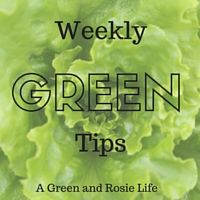Week 6 - Green Babies
To be truly green it is said that you should have no children and there are those termed GINK - Green Inclined, No Kids - who chose to remain child-free for just this reason. But in reality, for most people this isn't going to happen so as the next best step is for parents to look at how to reduce the impact their children have on the planet, starting from when baby first arrives. Hopefully parents will also help teach their children to be good green citizens and do more to protect the earth as through their children they have a vested interest to do so. Here are 7 tips to help you raise a green and sustainable baby.
1. Use cloth nappies
In Britain alone, 8 million nappies are thrown away EVERY day and this is not sustainable, especially when you realise that nappies take 400 years to degrade. So that first nappy you pooped in all those years ago is STILL festering somewhere in a landfill site. As an alternative there are cloth nappies as I blogged about previously.2. Buy second hand baby gear, clothes, toys etc.
Babies grow out of things so quickly making their clothes etc ideal for passing on to another lucky newborn. Newborn clothes that have been worn and washed a couple of times are even softer than newly bought clothes. So why not team up with other Mums and set up informal swapping sessions or use the various internet sites like Freegle or Freecycle.Second hand can extend to cots, push chairs, baby baths, high chairs etc etc. The only exceptions are car seats where you have no knowledge if the seat was involved in an accident and cot mattresses which the medical profession recommend buying new (although a little used second hand one in a very good state of repair is fine).
3. Breast feed if you can for as long as is possible
Breast milk is the ideal food for baby so where possible it is best to breast feed for as long as possible. However if, for what-ever reasons this is not possible do look for an organically produced formula milk.4. Make your own weaning food or go for baby-led weaning
When it comes to weaning (feeding your baby additional food to just milk) it is much better to make your own foods so you know exactly what is going into them. I remember puréeing parsnip for Tom even before he was born and freezing it in ice cube trays. I had an excess in the garden and he still loves parsnips to this day! Alternatively you can bypass purées completely and go for baby-led weaning.5. Use green detergents and eco-cleaning products
Remember that young babies have very thin skins and are more susceptible to chemicals than adults. Keeping your house toxic free is therefore great for baby and thus great for the environment too. There are plenty of good cleaning products available that are not full of harmful chemicals.6. Use non toxic products for baby
From wooden toys to non toxic bottles/cutlery/crockery etc, make sure the products you use for your baby are not harmful to either them or the environment. Again, where possible second-hand is great and then when you have finished with them you can pass them onto to another new baby. Parabens are thought to be particularly harmful and can be found in many products from shampoos to moisturisers including those meant specifically for babies, so do check labels carefully.7. Less is More
Babies really do not lead loads and loads of stuff . In Finland, all expectant mothers are given a strong cardboard box containing everything a newborn needs and the box even doubles up as a newborn crib. And it isn't that much stuff. |
| The Finnish Baby Box Image from the BBC |
Oh and do you really need need enough children to make up a football team? You might love the idea of a huge family but I am not sure the environment will thank you.
Having a baby is the most wonderful experience for anyone and there are plenty of ways that you can be green and a new parent. Do you have any more Green Baby Tips?





No comments :
Post a Comment
Note: only a member of this blog may post a comment.